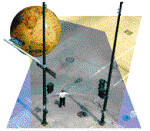Bahar
[It has been far too long since Cartophilia has visited Michael5000's Forgotten Lands. Today he posted an update to the forgotten Mediterranean land of Bahar, which inspired me to create some maps.]
Bahar
Capital: Djiranda
Population: 2,200,000 (1996 estimate)
Area: 54,000 km2
Independence: 1971
Economy: Major exports include Mediterranean agricultural products (grapes, dates, wheat), fish, and some oil. There is a growing industrial sector, of which leading products are glass, machine parts, and sporting equipment. Bahar’s currency, the Baharian lira has been pegged to the Euro since 2005.
Per Capita Income: US$11,530
Languages: English (official), Turkish, Greek, Arabic
Literacy Rate: 77%
A lush, fertile coastal land nestled against the mountains of Asia Minor, Bahar has always been, as Woodrow Wilson observed, “too rich to be free. She is forever coveted by her mighty neighbors” (Greenberg, American Mediterranean Policy and Practice, 1900-1940). Throughout recorded history, Bahar has been subject to a parade of empires: Greek, Macedonian, Roman, Byzantine, Ottoman, British, French, Italian (during the Second World War), and finally, until 1971, the British again.

Because of this “Colonial Tradition,” and despite four decades of independence, neither the world at large nor many of Bahar’s own citizens are accustomed to thinking of this small nation as a truly sovereign country. Still absent on most modern maps, Bahar is one of only four countries not to host a U.S. diplomatic mission as of 2010. Even within the capital, Djiranda, one sees few national flags or symbols, and “arguments in the tobacco bars and town plazas are more likely to be about the relative merits of football teams or fishing grounds than about national politics” (Fisher, Bahar and the Colonial Tradition).
Djiranda is one of a string of walled, whitewashed towns built up the steep cliffs that rise from the Mediterranean shore. Although modern stores and factories have been built inland, the alleys, plazas, homes, and storefronts within town walls look much as they have for centuries. Few tourists know to look for Bahar, but those who have spent time there typically rhapsodize over the beauty and charm of these ancient but vibrant ports. Djiranda, however, does have the reputation of being a difficult city for the casual visitor to navigate. Lacking the grand public buildings of most capitals – Bahar’s parliament meets in a nondescript office building facing a narrow side street – the city lacks obvious, immediately recognizable landmarks to navigate by.

Wine pressed from the grapes grown on the south-facing slopes of Bahar’s coastal hills has been declared among the world’s best by many leading authorities. Unfortunately, because production is still small-scale and largely structured to supply the domestic market, few enthusiasts have had a chance to sample the products of Bahar’s vintners.
 Flag: The three colors of Bahar’s flag are green, white, and black. The green field represents the agricultural underpinnings of Baharian society. The white stripe represents the sea, which Baharians consider to be not blue but clear. The black field, according to government literature, represents “our national mourning for four millennia of imperialist oppression.” When informed of this symbolism by this writer, one typical Baharian shrugged and replied “independent or not, it matters little.”
Flag: The three colors of Bahar’s flag are green, white, and black. The green field represents the agricultural underpinnings of Baharian society. The white stripe represents the sea, which Baharians consider to be not blue but clear. The black field, according to government literature, represents “our national mourning for four millennia of imperialist oppression.” When informed of this symbolism by this writer, one typical Baharian shrugged and replied “independent or not, it matters little.”National Anthem: “Our Freedom We Hold Sacred.”
Other Forgotten Lands on Cartophilia.
From Cartophiliac:
So, I created those two maps above, but I'm not quite happy with them. Bahar just looks too large. However, I tried to approximate the actual area in km2 that M5K used. So I created this map, below, that manages to nestle into the Turkish coast unobtrusively. Dear Readers, which version do you prefer?

Mega-Bonus points for anyone who can identify the geographic source for the shape of Bahar. A clue is in the text.
Labels: flags, forgotten lands, imaginary countries





4 Comments:
Oh yes.
Honestly, the smaller Bahar is closer to what I had imagined, but square kilometers don't lie. Also, there's apparently domestic air service, so the Bahar Grande is seeming more sensible.
Because of their proximity and common British occupation, I imagine there would be close trade ties with Cyprus.
From the shape (which looks a bit like a wolf's head), I'd guess... Venice or the Ragusan Republic?
I was looking for something of a comparable size...
Post a Comment
Subscribe to Post Comments [Atom]
<< Home